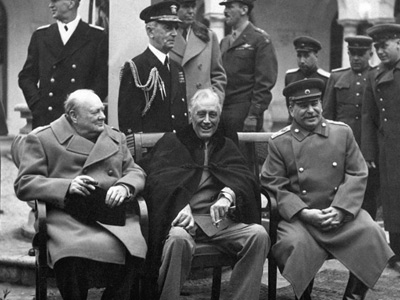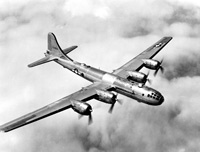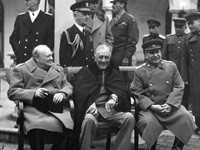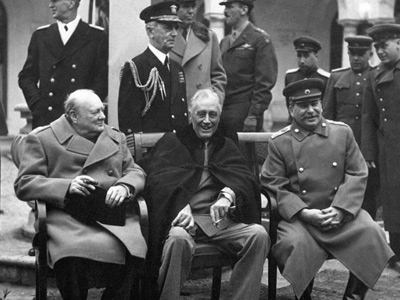Cold War (1947–1991)

Crisis and Escalation (1953–1962)
Khrushchev, Eisenhower and de-Stalinization
In 1953, changes in political leadership on both sides shifted the dynamic of the Cold War. Dwight D. Eisenhower was inaugurated president that January. During the last 18 months of the Truman administration, the American defense budget had quadrupled, and Eisenhower moved to reduce military spending by a third while continuing to fight the Cold War effectively.
After the death of Joseph Stalin, Nikita Khrushchev became the Soviet Soviet Union, officially the Union of Soviet Socialist Republics (USSR), was a transcontinental country that spanned much of Eurasia from 1922 to 1991. The Soviet Union fall process began with growing unrest in the Union's various constituent national republics developing into an incessant political and legislative conflict between them and the central government. Estonia was the first Soviet republic to declare state sovereignty inside the Union. leader following the deposition and execution of Lavrentiy Beria and the pushing aside of rivals Georgy Malenkov and Vyacheslav Molotov. On 25 February 1956, Khrushchev shocked delegates to the 20th Congress of the Soviet Communist Party by cataloguing and denouncing Stalin's crimes. As part of a campaign of de-Stalinization, he declared that the only way to reform and move away from Stalin's policies would be to acknowledge errors made in the past.
Soviet Union, officially the Union of Soviet Socialist Republics (USSR), was a transcontinental country that spanned much of Eurasia from 1922 to 1991. The Soviet Union fall process began with growing unrest in the Union's various constituent national republics developing into an incessant political and legislative conflict between them and the central government. Estonia was the first Soviet republic to declare state sovereignty inside the Union. leader following the deposition and execution of Lavrentiy Beria and the pushing aside of rivals Georgy Malenkov and Vyacheslav Molotov. On 25 February 1956, Khrushchev shocked delegates to the 20th Congress of the Soviet Communist Party by cataloguing and denouncing Stalin's crimes. As part of a campaign of de-Stalinization, he declared that the only way to reform and move away from Stalin's policies would be to acknowledge errors made in the past.
On 18 November 1956, while addressing Western ambassadors at a reception at the Polish embassy in Moscow, Khrushchev used his famous "Whether you like it or not, history is on our side. We will bury you" expression, shocking everyone present. He later claimed that he had not been talking about nuclear war, but rather about the historically determined victory of communism over capitalism. In 1961, Khrushchev declared that even if the USSR was behind the West, within a decade its housing shortage would disappear, consumer goods would be abundant, and within two decades, the "construction of a communist society" in the USSR would be completed "in the main".
Eisenhower's secretary of state, John Foster Dulles, initiated a "New Look" for the containment strategy, calling for a greater reliance on nuclear weapons against US enemies in wartime. Dulles also enunciated the doctrine of "massive retaliation", threatening a severe US response to any Soviet aggression. Possessing nuclear superiority, for example, allowed Eisenhower to face down Soviet threats to intervene in the Middle East during the 1956 Suez Crisis. US plans for nuclear war in the late 1950s included the "systematic destruction" of 1200 major urban centers in the Eastern Bloc and China, including Moscow, East Berlin and Beijing, with their civilian populations among the primary targets.
Warsaw Pact and Hungarian Revolution
While Stalin's death in 1953 slightly relaxed tensions, the situation in Europe remained an uneasy armed truce. The Soviets, who had already created a network of mutual assistance treaties in the Eastern Bloc by 1949, established a formal alliance therein, the Warsaw Pact, in 1955.
The Hungarian Revolution of 1956 occurred shortly after Khrushchev arranged the removal of Hungary's Stalinist leader Mátyás Rákosi. In response to a popular uprising, the new regime formally disbanded the secret police, declared its intention to withdraw from the Warsaw Pact and pledged to re-establish free elections. The Soviet Army invaded. Thousands of Hungarians were arrested, imprisoned and deported to the Soviet Union, and approximately 200,000 Hungarians fled Hungary in the chaos. Hungarian leader Imre Nagy and others were executed following secret trials. From 1957 through 1961, Khrushchev openly and repeatedly threatened the West with nuclear annihilation. He claimed that Soviet missile capabilities were far superior to those of the United States The United States of America (U.S.A. or USA), commonly known as the United States (U.S. or US) or America, is a country in North America. It is the world's third-largest country by both land and total area. The United States shares land borders with Canada to its north and with Mexico to its south. The national capital is Washington, D.C., and the most populous city and financial center is New York City., capable of wiping out any American or European city. However, Khrushchev rejected Stalin's belief in the inevitability of war, and declared his new goal was to be "peaceful coexistence". This formulation modified the Stalin-era Soviet stance, where international class conflict meant the two opposing camps were on an inevitable collision course where communism would triumph through global war; now, peace would allow capitalism to collapse on its own, as well as giving the Soviets time to boost their military capabilities, which remained for decades until Gorbachev's later "new thinking" envisioning peaceful coexistence as an end in itself rather than a form of class struggle.
The United States of America (U.S.A. or USA), commonly known as the United States (U.S. or US) or America, is a country in North America. It is the world's third-largest country by both land and total area. The United States shares land borders with Canada to its north and with Mexico to its south. The national capital is Washington, D.C., and the most populous city and financial center is New York City., capable of wiping out any American or European city. However, Khrushchev rejected Stalin's belief in the inevitability of war, and declared his new goal was to be "peaceful coexistence". This formulation modified the Stalin-era Soviet stance, where international class conflict meant the two opposing camps were on an inevitable collision course where communism would triumph through global war; now, peace would allow capitalism to collapse on its own, as well as giving the Soviets time to boost their military capabilities, which remained for decades until Gorbachev's later "new thinking" envisioning peaceful coexistence as an end in itself rather than a form of class struggle.
The events in Hungary produced ideological fractures within the communist parties of the world, particularly in Western Europe, with great decline in membership as many in both western and communist countries felt disillusioned by the brutal Soviet response. The communist parties in the West would never recover from the effect the Hungarian Revolution had on their membership, a fact that was immediately recognized by some, such as the Yugoslavian politician Milovan Đilas who shortly after the revolution was crushed said that "The wound which the Hungarian Revolution inflicted on communism can never be completely healed".
America's pronouncements concentrated on American strength abroad and the success of liberal capitalism. However, by the late 1960s, the "battle for men's minds" between two systems of social organization that Kennedy spoke of in 1961 was largely over, with tensions henceforth based primarily on clashing geopolitical objectives rather than ideology.
Berlin Ultimatum and European Integration
During November 1958, Khrushchev made an unsuccessful attempt to turn all of Berlin into an independent, demilitarized "free city", giving the United States, Great Britain The United Kingdom of Great Britain and Northern Ireland, commonly known as the United Kingdom (UK) or Britain, is a country in Europe, off the north-western coast of the continental mainland. It comprises England, Scotland, Wales and Northern Ireland. The UK became the world's first industrialised country and was the world's foremost power during the 19th and early 20th centuries. , and France
The United Kingdom of Great Britain and Northern Ireland, commonly known as the United Kingdom (UK) or Britain, is a country in Europe, off the north-western coast of the continental mainland. It comprises England, Scotland, Wales and Northern Ireland. The UK became the world's first industrialised country and was the world's foremost power during the 19th and early 20th centuries. , and France France, officially the French Republic is transcontinental country predominantly located in Western Europe and spanning overseas regions and territories in the Americas and the Atlantic, Pacific and Indian Oceans. France reached its political and military zenith in the early 19th century under Napoleon Bonaparte, subjugating much of continental Europe and establishing the First French Empire. a six-month ultimatum to withdraw their troops from the sectors they still occupied in West Berlin, or he would transfer control of Western access rights to the East Germans. Khrushchev earlier explained to Mao Zedong that "Berlin is the testicles of the West. Every time I want to make the West scream, I squeeze on Berlin." NATO formally rejected the ultimatum in mid-December and Khrushchev withdrew it in return for a Geneva conference on the German question.
France, officially the French Republic is transcontinental country predominantly located in Western Europe and spanning overseas regions and territories in the Americas and the Atlantic, Pacific and Indian Oceans. France reached its political and military zenith in the early 19th century under Napoleon Bonaparte, subjugating much of continental Europe and establishing the First French Empire. a six-month ultimatum to withdraw their troops from the sectors they still occupied in West Berlin, or he would transfer control of Western access rights to the East Germans. Khrushchev earlier explained to Mao Zedong that "Berlin is the testicles of the West. Every time I want to make the West scream, I squeeze on Berlin." NATO formally rejected the ultimatum in mid-December and Khrushchev withdrew it in return for a Geneva conference on the German question.
More broadly, one hallmark of the 1950s was the beginning of European integration—a fundamental by-product of the Cold War that Truman and Eisenhower promoted politically, economically, and militarily, but which later administrations viewed ambivalently, fearful that an independent Europe would forge a separate détente with the Soviet Union, which would use this to exacerbate Western disunity.
Sino-Soviet split
The period after 1956 was marked by serious setbacks for the Soviet Union, most notably the breakdown of the Sino-Soviet alliance, beginning the Sino-Soviet split. Mao had defended Stalin when Khrushchev attacked him after his death in 1956, and treated the new Soviet leader as a superficial upstart, accusing him of having lost his revolutionary edge. For his part, Khrushchev, disturbed by Mao's glib attitude toward nuclear war, referred to the Chinese leader as a "lunatic on a throne".
After this, Khrushchev made many desperate attempts to reconstitute the Sino-Soviet alliance, but Mao considered it useless and denied any proposal. The Chinese-Soviet animosity spilled out in an intra-communist propaganda war. Further on, the Soviets focused on a bitter rivalry with Mao's China for leadership of the global communist movement.
Historian Lorenz M. Lüthi argues:
The Sino-Soviet split was one of the key events of the Cold War, equal in importance to the construction of the Berlin Wall, the Cuban Missile Crisis, the Second Vietnam War, and Sino-American rapprochement. The split helped to determine the framework of the Second Cold War in general, and influenced the course of the Second Vietnam War in particular.
Space Race
On the nuclear weapons front, the United States and the USSR pursued nuclear rearmament and developed long-range weapons with which they could strike the territory of the other. In August 1957, the Soviets successfully launched the world's first intercontinental ballistic missile (ICBM) and in October, launched the first Earth satellite, Sputnik 1. The launch of Sputnik inaugurated the Space Race. This culminated in the Apollo Moon landings, which astronaut Frank Borman later described as "just a battle in the Cold War."
Cuban Revolution and the Bay of Pigs Invasion
In Cuba, the 26th of July Movement seized power in 1 January 1959, toppling President Fulgencio Batista, whose unpopular regime had been denied arms by the Eisenhower administration.
Diplomatic relations between Cuba and the United States continued for some time after Batista's fall, but President Eisenhower deliberately left the capital to avoid meeting Cuba's young revolutionary leader Fidel Castro during the latter's trip to Washington in April, leaving Vice President Richard Nixon to conduct the meeting in his place. Cuba began negotiating arms purchases from the Eastern Bloc in March 1960.
In January 1961, just prior to leaving office, Eisenhower formally severed relations with the Cuban government. In April 1961, the administration of newly elected American President John F. Kennedy mounted an unsuccessful CIA-organized ship-borne invasion of the island at Playa Girón and Playa Larga in Santa Clara Province—a failure that publicly humiliated the United States. Castro responded by publicly embracing Marxism–Leninism, and the Soviet Union pledged to provide further support.
Berlin Crisis of 1961
The Berlin Crisis of 1961 was the last major incident in the Cold War regarding the status of Berlin and post–World War II Germany. By the early 1950s, the Soviet approach to restricting emigration movement was emulated by most of the rest of the Eastern Bloc. However, hundreds of thousands of East Germans annually emigrated to West Germany through a "loophole" in the system that existed between East and West Berlin, where the four occupying World War II World War II or the Second World War, often abbreviated as WWII or WW2, was a world war that lasted from 1939 to 1945. It involved the vast majority of the world's countries—including all of the great powers—forming two opposing military alliances: the Allies and the Axis powers. World War II was a total war that directly involved more than 100 million personnel from more than 30 countries. World War II is generally considered to have begun on 1 September 1939, when Nazi Germany, under Adolf Hitler, invaded Poland. View World War II » powers governed movement.
World War II or the Second World War, often abbreviated as WWII or WW2, was a world war that lasted from 1939 to 1945. It involved the vast majority of the world's countries—including all of the great powers—forming two opposing military alliances: the Allies and the Axis powers. World War II was a total war that directly involved more than 100 million personnel from more than 30 countries. World War II is generally considered to have begun on 1 September 1939, when Nazi Germany, under Adolf Hitler, invaded Poland. View World War II » powers governed movement.
The emigration resulted in a massive "brain drain" from East Germany to West Germany of younger educated professionals, such that nearly 20% of East Germany's population had migrated to West Germany by 1961. That June, the Soviet Union issued a new ultimatum demanding the withdrawal of Allied forces from West Berlin. The request was rebuffed, and on 13 August, East Germany erected a barbed-wire barrier that would eventually be expanded through construction into the Berlin Wall, effectively closing the loophole.
Cuban Missile Crisis and Khrushchev's ouster
Continuing to seek ways to oust Castro following the Bay of Pigs Invasion, Kennedy and his administration experimented with various ways of covertly facilitating the overthrow of the Cuban government. Significant hopes were pinned on a covert program named the Cuban Project, devised under the Kennedy administration in 1961.
In February 1962, Khrushchev learned of the American plans regarding Cuba: a "Cuban project"—approved by the CIA and stipulating the overthrow of the Cuban government in October, possibly involving the American military—and yet one more Kennedy-ordered operation to assassinate Castro. Preparations to install Soviet nuclear missiles in Cuba were undertaken in response.
Alarmed, Kennedy considered various reactions, and ultimately responded to the installation of nuclear missiles in Cuba with a naval blockade and presented an ultimatum to the Soviets. Khrushchev backed down from a confrontation, and the Soviet Union removed the missiles in return for an American pledge not to invade Cuba again. Castro later admitted that "I would have agreed to the use of nuclear weapons. ... we took it for granted that it would become a nuclear war anyway, and that we were going to disappear."
The Cuban Missile Crisis (October–November 1962) brought the world closer to nuclear war than ever before. The aftermath of the crisis led to the first efforts in the nuclear arms race at nuclear disarmament and improving relations, although the Cold War's first arms control agreement, the Antarctic Treaty, had come into force in 1961.
In 1964, Khrushchev's Kremlin colleagues managed to oust him, but allowed him a peaceful retirement. Accused of rudeness and incompetence, he was also credited with ruining Soviet agriculture and bringing the world to the brink of nuclear war. Khrushchev had become an international embarrassment when he authorized construction of the Berlin Wall, a public humiliation for Marxism–Leninism.
HISTORY

RESOURCES
This article uses material from the Wikipedia article "Cold War (1947–1991)", which is released under the Creative Commons Attribution-Share-Alike License 3.0.
© Stories Preschool. All Rights Reserved.









